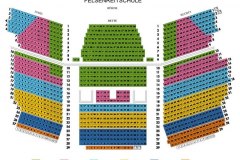Zaide or The Path of Light
Mo | Tu | We | Th | Fr | Sa | Su |
OPERA
Zaide or The Path of Light - Wolfgang Amadeus Mozart (1756 - 1791)
Semi-staged new production
Sung in German with German and English surtitles
An evening with excerpts from
ZAIDE
Singspiel in two acts K.344 (fragment, composed 1779—80)
DAVIDE PENITENTE
Cantata for soloists, choir and orchestra K. 469 (1785)
THAMOS, KÖNIG IN ÄGYPTEN
Incidental music for Tobias Philipp von Gebler’s heroic drama K. 345 (1773—80)
and other works from the period 1779—85
The preparation of Zaide in 1780 was a decisive turning point in Mozart’s career. This Singspiel, spontaneously composed for the Viennese court of the ‘enlightened despot’ Joseph II and left incomplete, shines for the humanist themes it explores. For the first time, Mozart built a musical and dramaturgical echo chamber for what he believed to be right and good: the fight against tyranny, the power of true love and, above all, the inalienable quest for freedom. Even if Zaide draws on clichés of the ‘rescue’ plot and on the rococo turqueries of the period as its starting points, it surpasses them in terms of the psychological depth with which Mozart portrays his characters, and the rare musical intensity of the drama.
Following Mozart’s first departure from Salzburg in 1777, great changes had taken place in his life: his decisive meeting with his new friend Haydn, his discoveries of Munich and of the Mannheim orchestra, his disappointed love for Aloysia Weber, his disillusionment in Paris and the tragic death of his mother. Mozart returned to Salzburg and to the service of Prince-Archbishop Colloredo with a heavy heart. However, he also returned to his native city profoundly changed. The large-scale vocal works he composed from then on carried the spirit of the Enlightenment and the philosophical and aesthetic movements that were stirring Europe. Zaide was the starting point for this new aesthetic, which refused to make concessions to gallant taste and instead explored the truth of the human soul. How can we fail to see a direct link between Mozart’s gradual emancipation from his tutelage (leaving Colloredo, leaving Salzburg, leaving his father) and his blossoming in the dramatic and sacred masterpieces to come: Idomeneo (1780—1), Die Entführung aus dem Serail (1781—2), the Great Mass in C minor (1782—3), and more.
What transforms us? What makes us better? These were the questions discussed in Europe during the Age of Enlightenment. Mozart, who was soon to be admitted to the Viennese Masonic lodge ‘Zur Wohltätigkeit’, made them his own by proposing a vision of humanity that, while never ceasing to be troubled by doubt, allows love and forgiveness to triumph.
In Libertà! Mozart & l’Opéra (2019), Pygmalion and Raphaël Pichon explored the musical and dramaturgical laboratory that preceded the three great masterpieces of the Mozart / Da Ponte trilogy. With this new creation for the Salzburg Festival, which delves into the rarely performed Zaide and Davide penitente (based on the Great Mass in C minor), along with other Mozart gems, they compose a humanist fresco where the individual and the collective respond to each other; where the battle between light and shadow is reenacted at every moment.
Eddy Garaudel
Program and cast
Raphaël Pichon - Concept and Musical Direction
Bertrand Couderc - Lighting
Eddy Garaudel - Dramaturgy
Cast
Sabine Devieilhe: Zaide
Lea Desandre: Persada
Julian Prégardien: Gomatz
Daniel Behle: Soliman
Johannes Martin Kränzle: Allazim
Pygmalion Choir & Orchestra
Felsenreitschule
It was Max Reinhardt who suggested that the Winter Riding School should be converted, and it was also his idea to transform the Summer Riding School (Felsenreitschule) into a theatre. During the first half of the 17th century conglomerate rock was quarried here for the building of the cathedral. In 1693, during the reign of Prince-Archbishop Johann Ernst Thun, according to plans by the Baroque master architect Johann Bernhard Fischer von Erlach, three tiers of 96 arcades were hewn into the walls of the disused quarry so that from here people could watch equestrian displays and animal baiting events.
In 1926, when Max Reinhardt first attempted to use the Felsenreitschule to stage Goldoni’s Servant of Two Masters for the Salzburg Festival, the ambience was ideal for the “realistic” character comedy in the style of popular theatre: the action took place on a so-called Pawlatschenbühne, a small raised platform, the ground consisted of compressed earth and the audience sat on wooden benches. In 1933 Clemens Holzmeister built a remarkable set for the production of Faust in the Felsenreitschule, the Faust Town which is still regarded as one of the most impressive transformations of this venue. The first opera production in the Felsenreitschule took place in 1948 when Herbert von Karajan conducted Gluck’sOrfeo ed Euridice.
From the end of the 1960s radical conversion and adaptation work took place, mainly according to plans by the “festival architect” Clemens Holzmeister. An understage area, an orchestral pit and a lighting bridge were installed, a weatherproof roll-back roof to offer protection against rain and cool summer evenings, and finally an auditorium with boxes and circles as well as a depot for scenery were created.
Jean-Pierre Ponnelle’s staging of Mozart’s Die Zauberflöte, which was presented here every summer from 1978 to 1986, achieved legendary status. The same is true of Shakespeare’s plays Julius Caesar, Coriolanus and Anthony and Cleopatra in the productions by Peter Stein and Deborah Warner (Coriolanus),which in the early 1990s were internationally acclaimed.
When the Haus für Mozart was built, the Felsenreitschule already received a new audience grandstand, which resulted in improved sightlines and acoustics for the audience.
Improvements are:
- A new roof construction with two fixed girders at the edges and three elements supported by five telescope cantilevers: the slightly inclined pitch roof consisting of three mobile segments resting on five telescope arms will be retractable and expandable within six minutes. Hanging points on the telescope cantilevers for stage technology (chain hoists), improved acoustical and heat protection and two lighting bridges will optimize the stage action.
- New security technology including electrical installations, stage lighting, effect lighting and effect sound.
- In addition, the interior expansion of the 3rd floor will be completed at that time, and the building shell of the newly constructed 4th floor under the roof of the Felsenreitschule will be made available to the Festival – this being the last instance in which new space can be created within the Festival District.

 EN
EN DE
DE IT
IT FR
FR ES
ES RU
RU JP
JP RO
RO
 Seating plan
Seating plan 